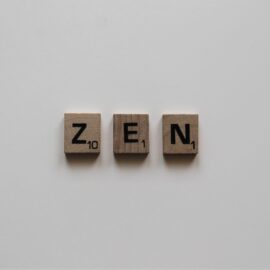

This article is an excerpt from the Shortform book guide to "Happy" by Derren Brown. Shortform has the world's best summaries and analyses of books you should be reading.
Like this article? Sign up for a free trial here.
How are Stoicism and happiness connected? What do the Stoics say about obtaining happiness?
We all want to be happy, but how to achieve happiness, or even how to define it, has been a problem that philosophers, theologians, and psychologists have long tried to solve. Author Derren Brown studied the Epicureans as well as Stoicism and happiness to draw conclusions about living a truly happy life.
Read on to learn why Brown says understanding Stoicism is one of the cornerstones of happiness.
The Cornerstones of Happiness
In Derren Brown’s Happy, instead of relying on modern self-help psychology or experts on setting and achieving personal goals, he turns to the works of ancient Greek philosophers for whom the quest for a happy, well-lived life was a practical problem to be addressed and solved. Drawing on theories of happiness and Stoicism as well as the teachings of the Epicureans, Brown says that by adopting a philosophy of our own, we can lead more thoughtful, balanced, and generally happier lives.
Drawing directly from the Stoics and Epicureans, Brown bases his philosophical approach to happiness on the age-old aphorism that the circumstances of our lives aren’t what make us unhappy, but rather how we react to them. Starting from this tenet, he suggests that the cornerstones of happiness are for us to choose contentment over perfection, take responsibility for our lives, and become the authors of our internal narratives.
Brown describes the groundwork that was paved by the early Greek thinkers, for whom the study of philosophy wasn’t merely an academic pursuit, but rather a search for practical values that would help people live happier lives. Some believed that happiness could be found in the contemplation of intangible ideals, such as the perfect abstraction of beauty. Others took a real-world approach and insisted that happiness could be achieved when a person became the best version of themselves. It was from the latter perspective that the Epicureans and the Stoics built their beliefs.
(Shortform note: In modern times, Stoicism has a bad reputation from the common belief that Stoics are unfeeling and detached from the world. Instead, it’s more accurate to say that Stoics are against emotions that cause pain, such as anger, envy, and fear. In The Obstacle Is the Way, Ryan Holliday describes Stoicism as empowering and optimistic. After all, if we accept the Stoic belief that only our thoughts make things good or bad, then every misfortune can become an opportunity if we reframe it as such.)
Epicureanism & Contentment
While Brown’s personal philosophy of happiness is more aligned with Stoicism, he first takes a look at the insights of the Epicureans, who equated happiness with tranquility. They achieved this tranquility by focusing on moderation, minimizing attachments, and cultivating healthy emotional lives.
Brown says that the Epicureans’ formula for happiness was simple—maximize pleasure and minimize pain. This led to the modern misperception that Epicurean philosophy was about indulging the senses with fine food and drink. However, the ancient Epicureans weren’t hedonists, instead believing that an excess of pleasure (as from wine) would result in an equivalent or greater pain (from the hangover). Epicureans found happiness in moderation and simplicity, shutting themselves away in monastic garden retreats where they ate simple meals and led simple lives far from the conflicts of the outside world.
(Shortform note: The modern version of Epicurean gardens can be found in the many health and wellness retreats available worldwide. While you can’t elect to move to a spa or meditation center full-time, studies show that even a week at a retreat has measurable benefits to physical and mental health. Retreats make it easier to turn off modern distractions and provide access to a community of support.)
The Epicureans also strove to rid themselves of material attachments, which they believed would inevitably lead to the pain of loss. This goes counter to our modern belief that happiness can be found by owning the next shiny and fashionable new product on the market. To be sure, there’s a pleasure to be found in buying a new car or the next model phone, but that happiness is doomed to be short-lived. The Epicurean response is not to deny yourself that pleasure, but rather to adjust your emotional life so that you’re content with the things you already own.
While that idea has become a cliché over time, Brown insists that being happy with what you have isn’t “settling.” Rather, it’s a deliberate choice. Contentment isn’t complacency; it takes practice and self-evaluation. Cultivating appreciation for the life we already have liberates us to focus on our needs rather than our wants. Feelings of attachment also apply to people as well as achievements or possessions, which we’ll circle back to later in this guide when we talk about living in the face of our own mortality.
| The Upside of Attachment In The Happiness Hypothesis, Jonathan Haidt takes a different view from Brown and the Epicureans. Instead of treating attachment as an inevitable source of pain, Haidt sees it as a natural part of human nature. Instead of trying to eliminate desire, he argues that you should learn to desire those things that are valuable to you and not possessions that merely signal your value to others, such as fancy jewelry or expensive cars that function as status symbols. Similarly, in The Happiness Project, Gretchen Rubin devoted a month to exploring how material attachment (in the form of recreational spending) affected her sense of well-being. She found that it was healthy to indulge in occasional “happiness splurges” but advises that what you buy should contribute to your sense of growth (such as tools to help you develop a hobby) and that you should use the things that you own so that they have meaningful value. |
Stoicism & Taking Responsibility
While the Epicureans introduced important ideas, Brown admits their lifestyle of withdrawal and nonattachment isn’t practical for 21st-century life. The Stoics, however, bring similar values to a philosophy of living a balanced life that’s fully engaged with the world around us. The central tenet of Stoicism is that happiness and suffering aren’t the result of what happens to us, but rather how we interpret those events. Brown explains that if we reframe our thoughts and let go of the things we can’t control, we can face any challenge or hardship with serenity.
(Shortform note: Another way of viewing Stoicism and happiness is that it’s a philosophy rooted in self-control. In The Daily Stoic, Ryan Holiday and Stephen Hanselman emphasize that the Stoics’ main tool for maintaining self-control is reason, which can be used to interrupt emotional responses and to question the assumptions underlying knee-jerk feelings.)
Central to this philosophy is the belief that our emotions derive from internal judgments—the stories we tell—and not directly from external causes. Our stories, says Brown, let us blame others (or bad luck) for our emotions. We create these stories between the triggering event and the emotion we feel without even being aware that we’re doing it.
For example, if you get turned down for a job, you may tell yourself that you’re not good enough and will never find work. Alternatively, you might think you were shortchanged or that the person who rejected you didn’t care how much it hurt. In either case, you might not consider that there could’ve been a stronger candidate for the job or that this rejection might give you the chance to find something better later on. The Stoics’ advice on happiness isn’t so trite as to “look on the bright side,” but to take responsibility for your own thoughts and feelings.
As in modern Cognitive Behavioral Therapy, Brown notes that the Stoics and Epicureans both insist that you can interrupt your inner voice and reframe your story. However, the Stoics double down on the idea that our internal emotional lives can be subjected to rational scrutiny. By reframing the judgments we make about what hurts us, even things such as illness and disability, the Stoics insist we can diminish our pain or even make it go away entirely.
| The Heart and the Mind Deliberately reframing your thoughts through self-talk is a staple of modern psychology as well as guides to business and achievement. In The Success Principles, Jack Canfield goes further to suggest that negative and positive thoughts have a physical effect on your body by changing your heart rate, respiration, and endorphin levels. Reframing and self-talk, therefore, can have a balancing effect on the body. However, not everyone agrees with the ancient Greek viewpoint that reason is capable of trumping emotion. In The Happiness Hypothesis, Jonathan Haidt argues the opposite—that we are emotionally driven creatures, and fighting to reign in our feelings will only lead to further unhappiness. The best we can do, says Haidt, is to recognize our emotionality as a vital part of our existence and reconcile it with our rational mind. |
Doing Your Best
Just because the Stoics believed that we all have the power to reduce our own pain, Brown says, it’s not fair to say that they turned a blind eye to the suffering of others or social injustice. The Stoics were very much engaged with the world, but they practiced non-attachment to the outcomes of their efforts. For example, when fighting against a system of oppression, the Stoic approach is to put forth your best effort, knowing that you’ll increase the chance of success while acknowledging the possibility that you might fail. The emotional value is in making the attempt and not tied to achieving a specific result.
(Shortform note: In The Daily Stoic, Ryan Holiday and Stephen Hanselman reaffirm the Stoics’ engagement in worldly issues by explaining that justice and courage are central Stoic values. However, acting on justice and courage takes energy and effort, which can tempt you to avoid discomfort and shirk responsibility. Doing so only offers short-term relief while letting injustice and unhappiness fester. The true Stoic learns to act now rather than later.)
After all, the point of Stoic philosophy isn’t to blame people for their own suffering but to empower them with a way out. The goal is to defuse pain, not compound it. Brown explains that our normal, human reaction to suffering when events feel out of our control is to try and exert control over something external, whether it’s food, relationships, or someone else’s opinion. In discussing the pursuit of happiness, Stoicism explains that all we can really control are our own thoughts and actions, and that’s where we should focus our attention.
(Shortform note: Taken to its negative extreme, a need for control can lead to codependency. In Codependent No More, Melody Beattie explains that attempting to control the people around you paradoxically gives control of your life to them, which ends up harming both sides of the relationship. The only means to effectively control the actions of others are manipulation and bullying, both of which are toxic to yourself and others.)
When we simply let go of what we can’t control, Brown notes two things that take place (or rather, don’t). First, nothing bad happens. For instance, if you stop trying to control whether someone else likes you, their opinion about you will not suddenly become worse. Second, when you let go of trying to control what you can’t, your feelings of failure disappear. Consider situations where you don’t control the outcome, such as asking someone out or applying for a job. If you do your part as best you can and let go of the idea that you’re responsible for the outcome, then you can’t feel like you failed even if the thing you hoped for doesn’t happen.
| Desperate to Be Liked Trying to control whether other people like you is a particularly effective recipe for unhappiness. It places your self-worth in someone else’s hands in such a way that their negative opinion will feel like a physical blow. It also creates the toxic belief that if the other person chooses not to like you, it’s your fault. In The Courage to Be Disliked, Ichiro Kishimi and Fumitake Koga identify two approaches we can take when interacting with others—we can try to earn their approval, or we can try to contribute positively to their lives. While most of us crave approval, it’s better emotionally to pursue the second option. If we care more about adding value than being liked, we can take pride in the effort. Whether or not it results in approval is no longer of emotional consequence. |

———End of Preview———
Like what you just read? Read the rest of the world's best book summary and analysis of Derren Brown's "Happy" at Shortform.
Here's what you'll find in our full Happy summary:
- The definition of happy, according to ancient Greek philosophers and Stoics
- The importance of balancing desires with realities
- How to overcome the three biggest barriers to happiness






